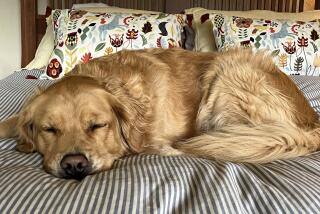A Clean Sleep
- Share via
It’s enough to keep you awake at night. That favorite pillow of yours--field of your dreams, launching pad of snores--is also fertile breeding ground for mold, mildew, fungus and dust mites. In short, all the things that can kick allergies into overdrive.
But before you go pillowless, or sleepless, consider this: The nation’s $5.9 billion-a-year bedding industry is launching so-called antimicrobial pillows and mattress pads, designed to curb microscopic creatures that can set you to wheezing and sneezing.
“When you’re sleeping, you breathe 2 pounds of moisture per night into the pillow or the room,” says Scott Trott, vice president of marketing for the Carpenter Co., one of the nation’s largest bedding manufacturers. “Then you get up in the morning and cover up the bed with blankets or sheets that trap the moisture in. So you go through a constant cycle of having a damp, dark place where microbes love to grow.”
Manufacturers claim that, unlike ordinary foam or down pillows, antimicrobial bedding goes after the mites and fungi that are attracted to skin and scalp flakes. The new pillows mix polyester with an acetate whose fibers have been spun with antimicrobial compounds, such as Microban or Allerban. As the acetate rubs against the polyester, small amounts of Microban are released--picture a soaker garden hose releasing water in all directions. As the microbes come in contact with the fibers, the antimicrobial additives break down the cells. Unlike topical treatments, these fibers can’t wash out.
If bedding-makers are treating antimicrobials like some prize pet, it’s not surprising: This is the first major pillow innovation since the 1989 introduction of Comforel, which added fluff, or “loft,” to foam. But bedding companies are only the latest in a growing roster of industries aiming to de-microbe us from head to toe. Ever since Nike marketed cross-training shoes with MicroSafe acetate inserts in 1995, “antimicrobial” has become the buzzword of the minute, elevating ordinary products from clinical to cool.
O-Cel-O makes antibacterial sponges intended to kill bacteria that can breed within. Lysol has an antimicrobial kitchen spray designed to tackle the E. coli and salmonella bacteria that can taint work surfaces. You can find antimicrobial dish towels, antimicrobial socks, antimicrobial underwear. And while it’s still too early to measure the antimicrobial tidal wave, one hint may come from QVC. When the television shopping network introduced an antimicrobial kitchen cutting board in June, it sold out--38,000 units at $19.98--in 24 hours.
*
Although the Asthma and Allergy Foundation of America estimates that 60 million Americans suffer from allergies, the appeal of antimicrobials is more broad-based. Just ask University of Arizona microbiologist Charles Gerba, who’s become something of a national sultan of slime. It’s Gerba’s recent down-and-dirty research that has underscored that there’s probably more disease-causing bacteria in our kitchens than in our bathrooms.
“The nature of the food supply is changing--it’s a more contaminated food supply,” he says. “A hundred years ago if you wanted a chicken, you’d go into the backyard, grab it by the neck and bring it into the house. Now 30% of the chicken supply has salmonella, and you’re bringing that into your food-preparation area.”
Gerba says 20% to 25% of all Americans are particularly sensitive to food-borne illnesses. And, as the population ages, he says, those numbers will probably increase. “If you get ill when you’re 35, it’s OK--you think you have the 24-hour flu,” he says. “But when you’re 65 or a young kid or on cancer drugs, it’s life-threatening.”
But if there is a note of urgency behind the development of antimicrobial kitchen products, pillow-makers were a bit more, well, laid-back. When chemical companies like DuPont and Hoechst Celanese approached pillow companies with antimicrobial fibers, “There was no sense that we had a burning need to develop this, no sense of we- have- a- bacteria- problem- in- our- pillows,” says Chris Baker, president of the bed-pillow division of Pillowtex. That attitude changed after companies successfully test-marketed antimicrobial pillows last fall; now, Baker says, “virtually every retailer who comes to our showroom wants to talk about our antibacterial products.”
Antimicrobial pillows can cost 15% to 20% more to make, but consumers won’t notice the difference for a while, since many manufacturers are introducing their wares at sale prices. At Pillowtex, which markets under the DuPont Allerban label, antimicrobial pillows start at about $8.99; at Carpenter, most antimicrobials are in the $9.99 to $14.99 range.
More to Read
Inside the business of entertainment
The Wide Shot brings you news, analysis and insights on everything from streaming wars to production — and what it all means for the future.
You may occasionally receive promotional content from the Los Angeles Times.








